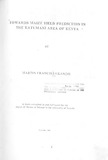Towards maize yield prediction in the Katumani area of Kenya
Abstract
In this study, attempts were made to relate yield
of maize grown at Katumani Agrometeorological Station to
rainfall and air temperature variables by who approaches.
In the first approach, yield was regressed on interphase
rainfall totals. The results indicate that the
flowering to wax ripeness interphase period is the most
Sensitive to unit changes in rainfall. They also indicate
that the approach cannot be used to predict yield till
end of the season when the best combination of variable's,
SER, ELR and FWR, can be obtained. A relatively stage
error was found presumably due to the use of data for a
short run.
In the second approach, the yield was regressed on
rainfall alone, then on rainfall and temperature combinations
employing Fisher's (1924) regression technique as modified
by Hendricks and Scholl (1943). The seasons were divided
into 3, 5, 7 and 1J-day periods~ First and second degree
equations were tried. The results were much improved.
Out of all the combinations of variables and periods,
rainfall and temperature range in 3-day periods in second
degree equation was best, giving a high coefficient of
determination and minimum error. Unlike the best equation
in the first approach this equation can at any tjme of
the season be used to assess the effect of weather v6riables
on maize yield. Much of the yield variability seems to be
vii
due to little and/or bad distribution of rainfall.
In using this equation, it was noted that the maize
is affected differently during its different stages of
growth and development. Above average 3-day totals of
rainfall had a favourable effect up to about tasseling/
flowering time, thereafter the effect was reduced, and
negative up to maturity. Above average 3-day temperature
range had a similar effect, being favorable up to about
tasseling time and then a progressively reduced and negative
effect up to maturity.
Citation
A thesis submitted in part fulfilment for the degree of Master of Science in the University of NairobiPublisher
Plant Science & Crop Protection

